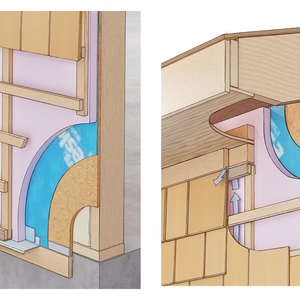Hi All. I am helping a friend do a kitchen and bath remodelling job in his 1950’s home. The walls are plaster and we are doing the repairs with Dap Plaster of Paris. We are having poblems because the stuff sets up within a matter of minutes. The instructions don’t day anything about how to make it more workable. Any ideas? Or should I just go to using drywall mud? Thanks.
Discussion Forum
Discussion Forum
Up Next
Video Shorts
Featured Story

Tips for picking the right paintbrush based on paint type, surface, and personal comfort.
Featured Video
Video: Build a Fireplace, Brick by BrickHighlights
"I have learned so much thanks to the searchable articles on the FHB website. I can confidently say that I expect to be a life-long subscriber." - M.K.
Fine Homebuilding Magazine
- Home Group
- Antique Trader
- Arts & Crafts Homes
- Bank Note Reporter
- Cabin Life
- Cuisine at Home
- Fine Gardening
- Fine Woodworking
- Green Building Advisor
- Garden Gate
- Horticulture
- Keep Craft Alive
- Log Home Living
- Military Trader/Vehicles
- Numismatic News
- Numismaster
- Old Cars Weekly
- Old House Journal
- Period Homes
- Popular Woodworking
- Script
- ShopNotes
- Sports Collectors Digest
- Threads
- Timber Home Living
- Traditional Building
- Woodsmith
- World Coin News
- Writer's Digest


















Replies
Oh Geez. I can imagine the trouble you're having. Get the mud mixed up, put in on the hawk, get up on staging, go to trowel it on...gummy and set up. Throw away and start over. Same result.
Problem is...Plaster of Paris isn't the kind of plaster you use for big repairs. Fine for tiny little ones but that's about it. Setup time is just too fast.
How big are the repairs you're doing?
How much of a hurry are you in?
Is the plaster you're repairing smooth or is there a texture?
If you're doing a really large area, real plaster comes in big bags, Diamond brand or Imperial brand are the two major ones. Setup time is hours, not minutes.
For medium-sized repairs (medium vs. large is up to you) use Durabond, a setting-type joint compound. It sets up via a chemical reaction called curing, like plaster, as opposed to just drying the way premixed joint compound does.
You can also just use "bucket mud," the joint compound that comes premixed. It tends to sag if the repairs are deep though, and it dries slowly.
Thanks Mike. I will try the Durabond but I will probably try the methods suggested by Jer and Doncando (on a couple of small patches) just for jun .
There's a ton of info you need to know about plaster if you're going to replaster. However, if you're just patching holes and your plaster is setting up too fast, I'll give you a few helpfuls.
First of all, if you're using plaster of Paris (POP), don't mix the stuff with a tool of any kind. POP is a setting type of plaster...in other words, it doesn't harden by air drying,...and the more you physically mix it, the faster it will set, sometimes within two to three minutes. POP hardens by the reintroduction of water into it and what happens is that the molecular structure actually crystallizes and changes, giving an exothermic reaction...it heats up.
So. What you want to do is to pour a little clean water into a mixing pail, add a cap full of white vinegar (a setting retarder), and then slowly sprinkle the POP into the water so it soaks into the plaster. You will see the plaster start to fissure and look 'wet'. When it all has turned that way, sprinkle a good dusting of the dry plaster over the top of it. Let is soak for 3-4 minutes. it will start to look wet again.
Now, take some regular joint compound and spoon it into the POP mix so you have even quantities of the two. Slowly mix it up, place it on your hawk or mud bucket and trowel it into place. If the mix is too loose, sprinkle in more dry POP and mix. Now you're ready to trowel it on. Learn to work fast with the stuff and only mix up the amount you think you can use in 10-15 minutes. Mix it thoroughly so there are no lumps.
When the stuff starts to stiffen up, wait until it's almost hard and keep smoothing a knife over it, and when it's hard enough to not leave a finger impression, swipe a very wet sponge over it and feather out the edges with the sponge, then run your knife over it one last time to smooth out the cream that is on top.
Or...You can go out and buy a dry patching compound like durabond, or the USG lite easy mix that takes about 45 minutes to harden. This stuff is also a setting type of compound but takes longer to set up. Personally I like the mix I do with POP, because of the short setting time. I can do several applications and repairs and have them paint -ready-smooth withing a half hour or so.
The other important thing too is to have all your repairs ready and prepped to go. Have them primed or wet with water so the old dry plaster doesn't suck all the water out of the fresh stuff and weaken it.
Plastering really is a one of those skills that takes many trials and that you eventually get a feel for. Three most important skill are mixing, application, and timing.
Good luck.
The vinegar and soaking method sounds interesting and I will give it a try. Thanks.
Unless you're a purist or need the hardness of plaster (like if the wall will be used for playing handball), just use drywall and joint compound. Shim out the wall so drywall can be installed flush with the plaster surface and tape and spackle all the seams. You may need to remove some old plaster to get a nice fit. Do not try to fill large voids with joint compound, but if you must, use a setting compound (like durabond) or plaster patching compound.
If you like experimenting, you can actually mix setting compound and POP. It works more like regular compound, but cures harder. I say "experiment" because I can't give you exact ratios. I've done it with success and I'm guessing the ratio was around 10 to 1, compound to POP.
Thanks for the reply. I will probably use the layers of Durabond on the bigger patches but I do like to experiment so I'll try a (small) patch with a setting compound. thanks.
I would not use premixed drywall mud. Too many problems with bonding to old plaster. The setting type like Durabond 90 or Easysand 90 would be what you want. The number indicates the approx amt of time it is workable. This varies with water temp. cold water can make it take a bit longer. Hot water can make it go off on you real quick.
DB 45 for smaller patches
DB 90 is a good normal mix. You can mix a batch the size you would use in an hour or so, use it up, clean tools and take coffee break. Then repeat the process and take lunch....
I also use a bonding agent first to old plaster to seal and bond.
Also, most damaged old plaster has some grit that will try to flake out into what you are working. Use the vac on the blow side to get rid of a lot of that first, then use the sealing bonding agent, let it get tacky, then do the repairs
Welcome to the
Taunton University of Knowledge FHB Campus at Breaktime.
where ...
Excellence is its own reward!
I have been doing some small repairs, following a plasterer who didn't use a bonding agent in his skim coats over the old plaster.
His mud when dry just falls off the wall. This bonding agent you mention sounds like something I need to look into. What brands would you suggest?
Matt- Woods favorite carpenter.
"What brands would you suggest? "Drylock is one. I think you can get it at HD. It's white and is often called 'milk' when used in masonry. Also Thoroseal makes a bonding agent, and lastly the one I always use is called Plasterweld, and I forget who makes it but you can get it online. Just make sure it's meant for bonding both mason and plaster..I like to use white pigmented alcohol base primer to paint on any of the potentially crumbly parts of the old browncoat plaster, then I use the bonding agent. The primer really penetrates and consolidates the stuff. Just make sure all the loose stuff is taken off and vacuumed up.
Thanks Jer I have heard of Plasterweld before and I think the local Lowes has it stock. I'll be sure to look for it.
Matt- Woods favorite carpenter.
Whatever is available.You can use a white PVA glue, Weldbond, Acrril60, etc,SW has a good sealer bonder primer prep for stuff like this that my painter uses that is probably higher in PVA than most primers.Where you are buying your plaster supplies they probably stock one specific to their brand of plaster....
Welcome to the Taunton University of Knowledge FHB Campus at Breaktime. where ... Excellence is its own reward!
White plastic jug of "deck-O-weld" is what I've used. Looks like white Elmer's glue--and probably is.
Not to derail, but I also am about to patch some plaster veneer over some, ( from the 50's, like dw only 2'x3'sheets..rock lath??)
Only doing a couple cracks. In the past I have chipped off the finish coat(about an 1/8"), on both sides of the crack, and bedded some mesh tape in some setting mud , then finished with d/w mud.
Have not seen Durobond, is the setting stuff from Home despot close enuff???
Bud
That's the stuff. Durobond is just a brand name.
Mike HennessyPittsburgh, PA
Ok, tnx , just wanted to make sure...
Bud
the details on the types and the water are really useful. thanks for your reply.
Check out this thread- http://forums.taunton.com/tp-breaktime/messages?msg=96463.1
Forest makes it pretty clear
Mike
Trust in God, but row away from the rocks.
Edited 11/17/2007 6:34 pm by ruffmike